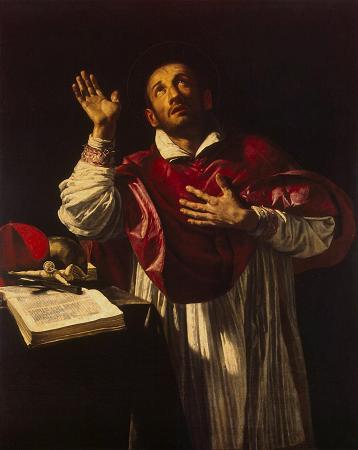Saint Carlo Borromeo. Charles Borromeo was the Latin archbishop of Milan from 1564 to 1584 and a cardinal of the Catholic Church. He was a leading figure of the Counter-Reformation combat against the Protestant Reformation together with St. Ignatius of Loyola and St. Philip Neri. In that role he was responsible for significant reforms in the Catholic Church, including the founding of seminaries for the education of priests. He is honored as a saint by the Catholic Church, with a feast day on November 4. Charles was a descendant of nobility: the Borromeo family was one of the most ancient and wealthy in Lombardy, made famous by several notable men, both in the church and state. The family coat of arms included the Borromean rings, which are sometimes taken to symbolize the Holy Trinity. Charles' father Gilbert was Count of Arona. His mother Margaret was a member of the Milan branch of the House of Medici. The third son in a family of six children, he was born in the castle of Arona on Lake Maggiore 36 miles from Milan on 2 October 1538. Borromeo received the tonsure when he was about twelve years old. At this time his paternal uncle Giulio Cesare Borromeo turned over to him the income from the rich Benedictine abbey of Sts. Gratinian and Felin, one of the ancient perquisites of the family. Charles made plain to his father that all revenues from the abbey beyond what was required to prepare him for a career in the Church belonged to the poor and could not be applied to secular use. The young man attended the University of Pavia, where he applied himself to the study of civil and canon law. Due to a slight impediment of a speech he was regarded as slow but his thoroughness and industry meant that he made rapid progress. In 1554 his father died, and although he had an elder brother, Count Federico, he was requested by the family to take the management of their domestic affairs. After a time, he resumed his studies, and on 6 December 1559, he earned a doctorate in canon and civil law. On 25 December 1559 Borromeo's uncle Cardinal Giovanni Angelo Medici was elected as Pope Pius IV. The newly-elected pope required his nephew to come to Rome, and on 13 January 1560 appointed him protonotary apostolic. Shortly thereafter, on 31 January 1560, the pope created him cardinal, and thus Charles as cardinal-nephew was entrusted with both the public and the privy seal of the ecclesiastical state. He was also brought into the government of the Papal States and appointed a supervisor of the Franciscans, Carmelites and Knights of Malta. During his four years in Rome Borromeo lived in austerity, obliged the Roman Curia to wear black, and established an academy of learned persons, the Academy of the Vatican Knights, publishing their memoirs as the Noctes Vaticanae. Charles organized the third and last session of the Council of Trent, in 1562-63. He had a large share in the making of the Tridentine Catechism. In 1561, Borromeo founded and endowed a college at Pavia, today known as Almo Collegio Borromeo, which he dedicated to St. Justina of Padua. On 19 November 1562, his older brother, Federico, suddenly died. His family urged Charles to seek permission to return to the lay state, to marry and have children so that the family name would not become extinct, but he decided not to leave the ecclesiastic state. His brother's death, along with his contacts with the Jesuits and the Theatines and the example of bishops such as Bartholomew of Braga, were the causes of a conversion of Charles towards a more strict and operative Christian life, and his aim became to put into practice the dignity and duties of the bishop as drafted by the recent Council of Trent. Charles was appointed an administrator of the Archdiocese of Milan on 7 February 1560. After his decision to put into practice the role of bishop, he decided to be ordained priest and on 7 December 1563 he was consecrated bishop in the Sistine Chapel by Cardinal Giovanni Serbelloni. Charles was formally appointed archbishop of Milan on 12 May 1564 after the former archbishop Ippolito II d'Este waived his claims on that archbishopric, but he was only allowed by the pope to leave Rome one year later. Charles made his formal entry into Milan as archbishop on 23 September 1565. After the death of his uncle, Pius IV, Charles contributed materially to suppressing the cabals of the conclave. Before Charles went to Milan, while he was overseeing reform in Rome, a nobleman remarked that the latter city was no longer a place to enjoy oneself or to make a fortune.
more...





